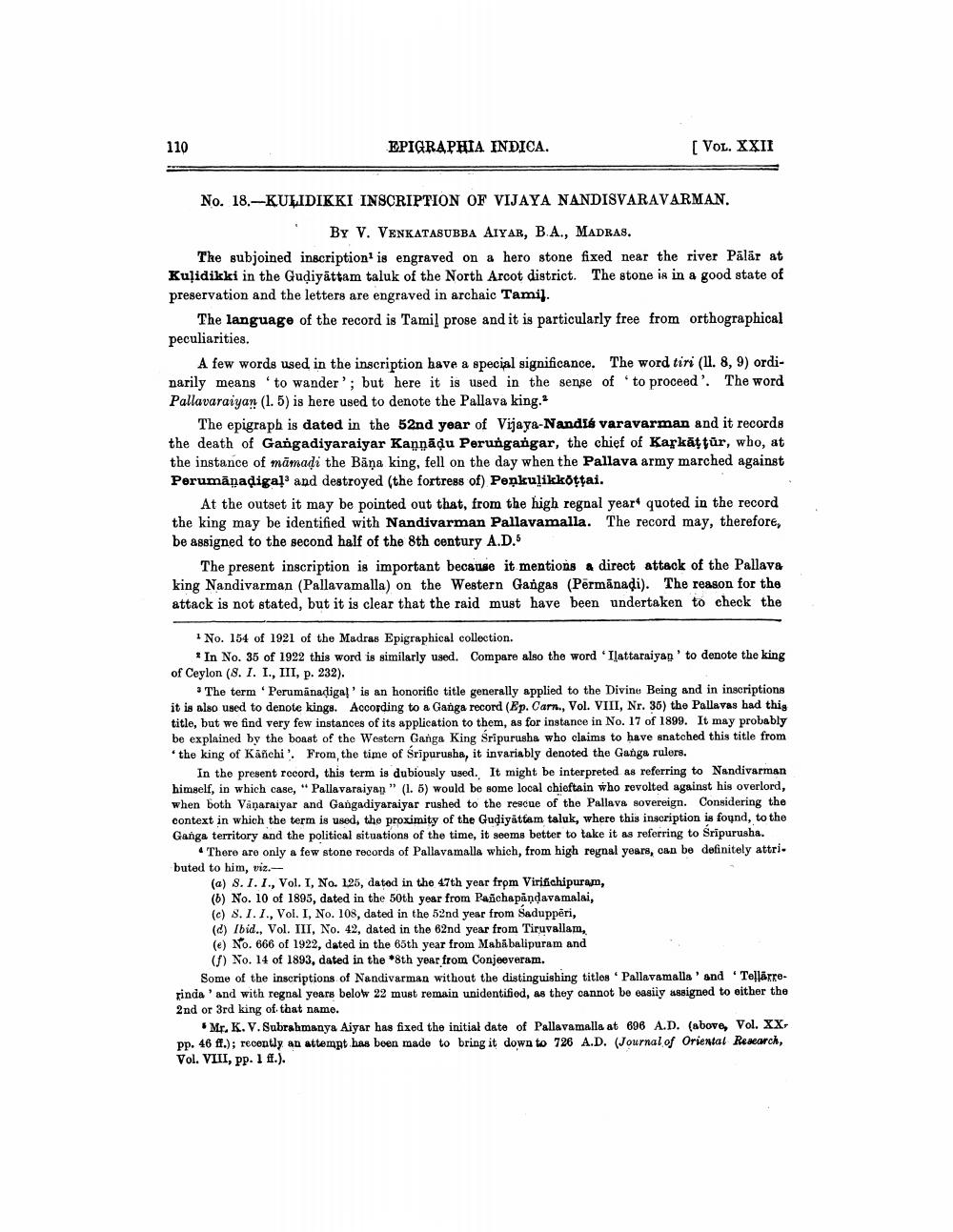________________
110
EPIGRAPHIA INDICA.
[VOL. XXII
No. 18.-KULIDIKKI INSCRIPTION OF VIJAYA NANDISVARAVARMAN.
BY V. VENKATASUBBA AIYAR, B.A., MADRAS. The subjoined inscription' is engraved on a hero stone fixed near the river Pälär at Kuļidikki in the Gudiyattam taluk of the North Arcot district. The stone is in a good state of preservation and the letters are engraved in archaic Tamil.
The language of the record is Tamil prose and it is particularly free from orthographical peculiarities.
A few words used in the inscription have a special significance. The word tiri (11. 8, 9) ordinarily means 'to wander'; but here it is used in the sense of 'to proceed'. The word Pallavaraiyan (1.5) is here used to denote the Pallava king.
The epigraph is dated in the 52nd year of Vijaya-Nandis varavarman and it records the death of Gangadiyaraiyar Kannādu Perungangar, the chief of Kapkāt tūr, who, at the instance of mamadi the Bäna king, fell on the day when the Pallava army marched against Perumånadigal' and destroyed (the fortress of) Ponkulikkottai.
At the outset it may be pointed out that, from the high regnal yeart quoted in the record the king may be identified with Nandivarman Pallavamalla. The record may, therefore, be assigned to the second half of the 8th century A.D.
The present inscription is important because it mentions a direct attack of the Pallava king Nandivarman (Pallavamalla) on the Western Gangas (Permānadi). The reason for the attack is not stated, but it is clear that the raid must have been undertaken to check the
* No. 154 of 1921 of the Madras Epigraphical collection.
* In No. 35 of 1922 this word is similarly used. Compare also the word 'Ilattaraiyan' to denote the king of Ceylon (8. 1. I., III, p. 232).
The term 'Perumânadiga!' is an honorific title generally applied to the Divine Being and in inscriptions it is also used to denote kings. According to a Ganga record (Ep. Carn., Vol. VIII, Nr. 35) the Pallavas bad thig title, but we find very few instances of its application to them, as for instance in No. 17 of 1899. It may probably be explained by the boast of the Western Ganga King Sripurusha who claims to have snatched this title from the king of Kanchi'. From the time of Sripurusha, it invariably denoted the Ganga rulers.
In the present record, this term is dubiously used. It might be interpreted as referring to Nandivarman himself, in which case, "Pallavaraiyan" (1. 5) would be some local chieftain who revolted against his overlord, when both Vanaraiyar and Gangadiyaraiyar rushed to the rescue of the Pallava sovereign. Considering the context in which the term is used, the proximity of the Gudiyattam taluk, where this inscription is found, to the Ganga territory and the political situations of the time, it seems better to take it as referring to Sripurusha.
There are only a few stone records of Pallavamalla which, from high regnal years, can be definitely attri. buted to him, viz.
(a) 8.1. I., Vol. I, No. 125, dated in the 47th year from Virifichipuram, (6) No. 10 of 1895, dated in the 50th year from Panchapandavamalai, (c) S. 1. 1., Vol. I, No. 108, dated in the 52nd year from Sadupperi, (c) Ibid., Vol. III, No. 42, dated in the 62nd year from Tiruvallam, (e) No. 666 of 1922, dated in the 65th year from Mahabalipuram and
(1) No. 14 of 1893, dated in the 8th year from Conjeeveram.
Some of the inscriptions of Nandivarman without the distinguishing titles Pallavamalla' and 'Tellarrerinda ' and with regnal years below 22 must remain unidentifiod, as they cannot be easily assigned to either the 2nd or 3rd king of that name.
Mr. K.V.Subrahmanya Aiyar has fixed the initial date of Pallavamalla at 696 A.D. (above, Vol. XXpp. 46 ff.); recently an attempt has been made to bring it down to 726 A.D. (Journal of Oriental Research, Vol. VIII, pp. 1 ff.).




